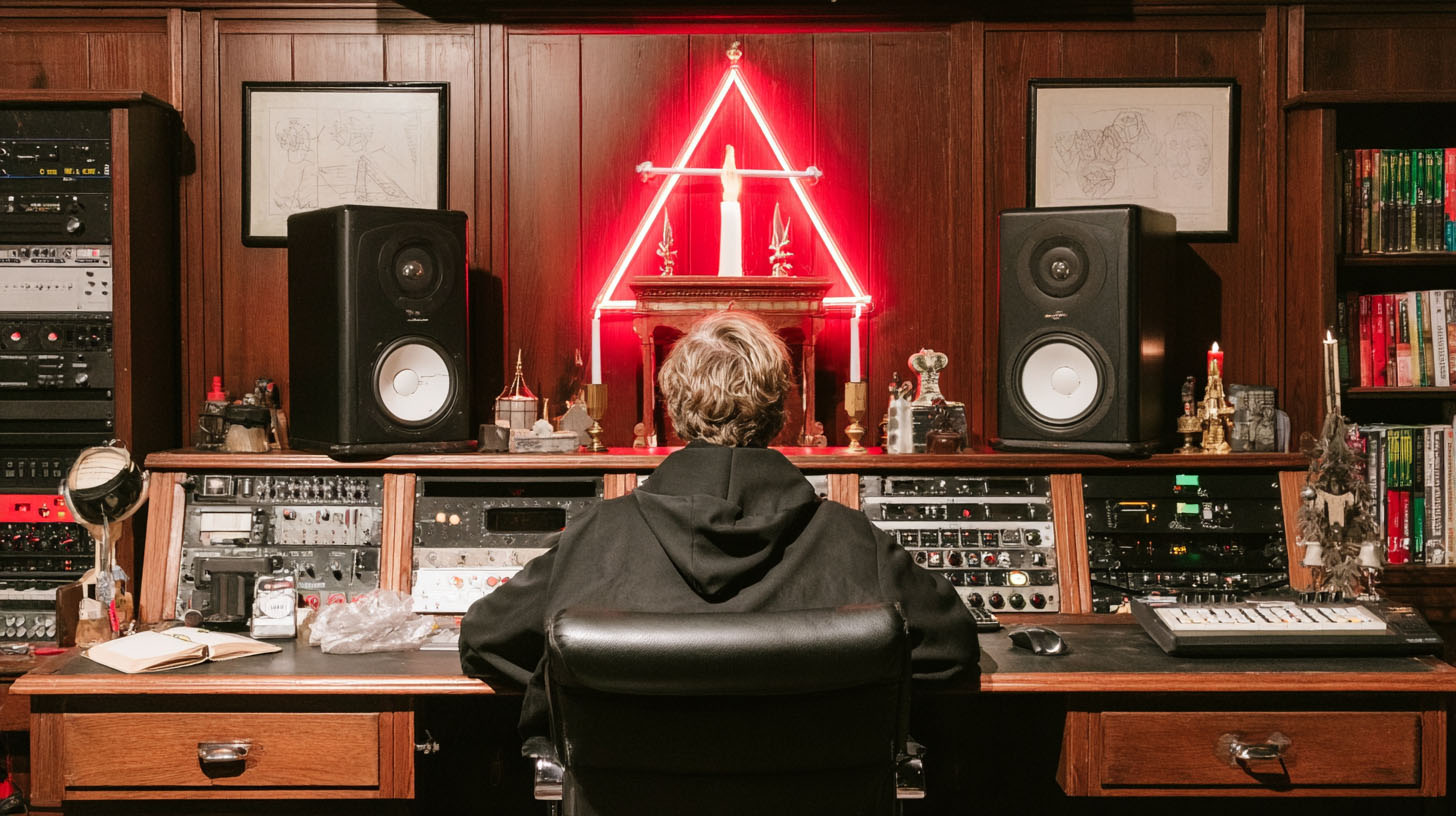
What Is Auto-Tune? More Than Just Robot Vocals in Metal
Nail The Mix Staff
Alright, let's talk Auto-Tune. For a lot of folks, the phrase conjures up images of T-Pain, Cher, or those ultra-robotic pop vocals. And yeah, it can do that. But if you're mixing heavy music, you know (or you should know) that Antares Auto-Tune and similar pitch correction tools are way more versatile and, honestly, pretty damn essential in the modern metal producer's toolkit.
We’re not just talking about polishing up clean singing here. From subtly tightening up a ferocious scream to ensuring those layered harmonies are knife-edge precise, pitch correction is a secret weapon. So, let's dive deep into what Auto-Tune actually is, how it works, and how you can wield it to make your metal tracks sound absolutely monstrous.
So, What Exactly IS Auto-Tune Anyway?
At its core, Auto-Tune, originally developed by Antares Audio Technologies, is a software plugin (VST, AU, AAX – you know the drill) designed to detect the pitch of a monophonic audio signal (like a vocal or a solo instrument) and shift it to a desired pitch. Usually, this means correcting it to the nearest in-tune semitone within a specified musical scale.
Think of it like this: a vocalist hits a note that's a little flat. Auto-Tune "hears" it, figures out what the intended note was (based on the key you tell it, or just chromatically), and nudges it up. The speed and smoothness of this "nudging" are what determine whether it sounds like a natural correction or that classic hard-tuned effect.
It's not magic, but sophisticated algorithms analyzing frequency and making real-time adjustments. And while the brand "Auto-Tune" is iconic, the general process is known as pitch correction, with several powerful alternatives on the market.
Auto-Tune in Metal: It’s Not Just for Clean Vocals, Bruh
This is where it gets really interesting for us metalheads. While pop might use it for an obvious effect, in metal, it’s often about surgical precision and enhancement, even on the gnarly stuff.
Screamed & Growled Vocals: Taming the Beast
You might think, "Auto-Tune on screams? Seriously?" Absolutely.
- Tightening Inconsistencies: Even the best screamers can have slight pitch variations or moments where a scream’s tonal center wavers. Subtle Auto-Tune can help solidify these, making them hit harder and feel more controlled without sounding "tuned." You're aiming for consistency, not a robot growl (unless that's your vibe!).
- Enhancing Pitch Definition: Sometimes a guttural vocal can sound a bit undefined. A touch of pitch correction can bring out a more discernible (though still aggressive) tonal center, helping it cut through a dense mix of distorted guitars.
- Fixing "That One Note": Ever had a killer scream that just had one moment that felt a bit… off? Instead of re-tracking endlessly, a quick, careful tweak in Auto-Tune Pro's Graphical Mode can save the take.
For this kind of work, you’ll typically use very light settings – slow Retune Speeds, perhaps some Flex-Tune to allow natural variations. Plugins like Antares Auto-Tune Pro or Waves Tune Real-Time are go-tos.
Polishing Clean Vocals in Metal
This is more straightforward but equally vital. Modern metal often features soaring clean vocal passages (think Spencer Sotelo from Periphery or Daniel Tompkins from TesseracT). Achieving that polished, pro sound almost always involves meticulous pitch correction.
- Achieving Perfection: It’s about getting those notes dead-on, creating a super-tight and impactful vocal performance.
- Naturalness is Key: The goal here is usually transparency. You don’t want it to sound tuned. This means careful attention to Retune Speed, Humanize, and possibly manual graphical editing for tricky phrases or vibrato.
Crushing Backing Vocals & Harmonies
This is where Auto-Tune can be a massive timesaver and quality booster.
- Super Tight Harmonies: Layered vocal harmonies are a staple in many metal subgenres. Auto-Tune ensures every layer is perfectly in sync pitch-wise, creating a massive, cohesive sound. You can often be a bit more aggressive with the settings on backing vocals as they're tucked under the lead.
- Thickening Power: Even if the lead vocal is mostly natural, tuning doubles and harmony parts tightly can add immense power and polish.
Auto-Tune vs. The World: Melodyne and Other Pitch Correction Powerhouses
Auto-Tune isn’t the only sheriff in town. Let’s look at the main players:
Celemony Melodyne: The Surgical Scalpel
Melodyne is often seen as the king of detailed, transparent pitch editing.
- Granular Control: Melodyne (especially versions like Editor or Studio) offers incredible note-by-note graphical editing. You see "blobs" representing notes, and you can drag pitch, timing, drift, vibrato, formants – you name it.
- DNA (Direct Note Access): Melodyne's party trick is its ability to analyze and edit polyphonic material (like chords on a piano or guitar). While less critical for typical lead vocal tuning, it's a game-changer for other tasks.
- When to Use Melodyne: For incredibly nuanced pitch shaping, deep formant editing, correcting complex vibrato issues, or when you need absolute surgical precision. If a vocal performance is really off or needs creative re-pitching, Melodyne shines.
- Auto-Tune vs. Melodyne for Metal Vocals: For quick, real-time correction or if you like Auto-Tune’s specific character (especially the classic "hard tune" or its smooth, modern sound), Antares is often faster. For intricate, almost invisible surgery, many reach for Melodyne. Both are top-tier; it often comes down to workflow preference and the specific task.
Your DAW's Stock Tuner: Don’t Sleep On It!
Most major DAWs come with surprisingly capable built-in pitch correction tools:
- Logic Pro X: Flex Pitch
- Cubase: VariAudio
- Pro Tools: Elastic Pitch (though many prefer dedicated plugins)
- Reaper: ReaTune
These can absolutely get professional results, especially if you take the time to learn their ins and outs. This ties into a broader point: it matters which plugins you use… to a degree. For highly specific tasks, like wanting the exact sound of an EVH 5150 amp sim or needing Soothe2 to tame harsh guitar fizz, then yes, the specific plugin is crucial. But for more generalized tasks, like basic EQ or transparent pitch correction, your skill with the tool often trumps the brand name. If you're a wizard with Flex Pitch, you can achieve fantastic results without spending extra.
Other Notable Contenders
- Waves Tune / Waves Tune Real-Time: Long-standing competitors to Auto-Tune, offering a slightly different flavor and workflow. Waves Tune Real-Time is excellent for live tracking or quick fixes.
- iZotope Nectar (Pitch Module): Part of a comprehensive vocal processing suite, Nectar’s pitch correction is solid and integrates well if you're already in the iZotope ecosystem.
- Synchro Arts Revoice Pro: While its primary strength is aligning the timing and pitch of multiple audio tracks (amazing for ADR or tightening vocal stacks), it also has powerful tuning capabilities.
Getting Under the Hood: Key Auto-Tune Parameters (and How to Use 'Em)
Let’s crack open Antares Auto-Tune Pro and look at the knobs and buttons that matter for metal:
- Input Type: CRITICAL. Set this correctly (Soprano, Alto/Tenor, Low Male, Instrument, etc.) for Auto-Tune to accurately detect the incoming pitch. Garbage in, garbage out.
- Key and Scale: Tell it the song's key and scale (e.g., C Minor). This helps it make more intelligent decisions. For chromatic, aggressive vocals or if you're unsure, "Chromatic" is a safe bet, but you'll need to be more careful.
- Retune Speed: The big one.
- 0-10ms: You're in "T-Pain" territory. That hard, robotic effect. Can be cool for specific vocal layers or effects in metalcore or industrial metal.
- 20-50ms: A common starting point for modern, polished vocals. Still quite strong but can sound "pro" if the performance is close.
- 50-100ms+: More natural, subtle correction. Good for just nudging things into place without obvious artifacts, especially on aggressive vocals where you want to retain character.
- Metal Tip: For harsh vocals, you might start slower (e.g., 60-80ms) and speed it up until you just start to hear it, then back off. For clean vocals, experiment in the 20-60ms range.
- Humanize: When using slower Retune Speeds on sustained notes, Humanize can add back a touch of natural pitch variation, preventing notes from sounding unnaturally static.
- Flex-Tune: Allows more of the original pitch variation to pass through before correction engages. Great for preserving natural scoops, bends, and vibrato, making the tuning less aggressive and more transparent. Crucial for natural-sounding cleans.
- Vibrato Controls (Create/Adjust Vibrato): You can enhance, reduce, or even synthesize vibrato. Use with caution – artificial vibrato can sound very fake if overdone.
- Formant Correction (Transpose & Throat):
- Formants are the resonant frequency peaks that give a voice its unique timbre. When you pitch-shift a vocal significantly without formant correction, you get the "chipmunk" (pitched up) or "Darth Vader" (pitched down) effect.
- Enabling Formant correction (or adjusting Throat Length in some versions) helps maintain a natural vocal tone even with larger pitch shifts. Essential if you're doing heavy correction or harmony generation.
- Auto Mode vs. Graphical Mode:
- Auto Mode: The classic set-it-and-forget-it (or continuously tweak it) mode. Great for real-time processing and general correction.
- Graphical Mode: Lets you manually draw in pitch curves, adjust note objects, and fine-tune every nuance. This is where you get Melodyne-like precision within Auto-Tune Pro. Indispensable for detailed work on lead vocals.
Beyond Pitch: Creative Uses of Auto-Tune in Metal Production
It’s not just about fixing mistakes!
- The Deliberate "Effect": Some modern metalcore, electronicore, or experimental metal bands (think early Asking Alexandria or I See Stars) lean into the hard-tuned sound as a stylistic choice. Fast Retune Speed, maybe some MIDI control for robotic melodies.
- Extreme Vocal Layering: Tuning backing vocals or gang shouts with a super-fast Retune Speed can create an almost synth-like, ultra-tight texture when blended underneath more natural leads.
- Instrument "Tuning" (Use Sparingly): While primarily for vocals, Auto-Tune can track monophonic instruments. Need to fix a slightly off note in a synth lead or a fretless bass line? It can work. But dedicated tools or manual editing are often better for instruments.
The Plugin Philosophy: Does Which Tuner Really Matter?
This is a big one, and it applies to all plugins, not just pitch correction. Our take at Nail The Mix? It matters, but maybe not as much as you think, and not always in the way you think.
- Specific Tasks, Specific Tools: If you want that classic Antares Auto-Tune 5 sound for a throwback effect, then yes, you need that plugin. If you need Melodyne's DNA to detangle a poorly recorded acoustic guitar chord, then Melodyne is your huckleberry. These are specialized needs.
- General Purpose? Skill Trumps Brand: For general, transparent pitch correction, most modern tools – Auto-Tune Pro, Melodyne Essentials, Waves Tune, even your DAW’s stock plugin like Logic's Flex Pitch or Cubase's VariAudio – can get you professional results. What matters most is your skill and your ear. Someone who deeply understands vocal production can make a stock plugin sing, while someone inexperienced can make even Auto-Tune Pro sound awful.
- Workflow & Comfort = Better Results: The plugin whose GUI clicks with your brain, whose workflow doesn't slow you down, is often the "best" one for you. If Auto-Tune's layout feels intuitive, you'll likely make better decisions faster. If iZotope Ozone’s interface intimidates you, you might not unlock its full potential, even if it's technically powerful.
- Ditch the Plugin GAS (Gear Acquisition Syndrome): You don't need twenty different pitch correction plugins. Seriously. Most of us who've been mixing for a while have bought plugins hoping for a magic bullet, only to realize that what really changes your mixes are your skills. Master one or two really well. Learn their strengths, weaknesses, and how to push them. This is far more valuable than a bloated plugin folder.
- This deep understanding is exactly what we champion at Nail The Mix. It’s not just about what buttons to press, but why and when. If you're ready to move past chasing plugins and truly elevate your mixing game, see how the pros make these decisions in real-world sessions. You can Unlock Your Sound: Mixing Modern Metal Beyond Presets and learn directly from the best.
- Latency & Phase: The Sneaky Gremlins: Pitch correction plugins, especially those doing complex analysis or offering low-latency modes for tracking, can introduce processing delay. Most DAWs have Automatic Delay Compensation (ADC), but it's not always perfect, especially with intricate routing or when you're pushing its limits (Pro Tools users from the mid-2000s know the pain of manual delay compensation for parallel processing!).
- Be mindful of this, especially if you're parallel processing tuned vocals. Phasing issues can creep in if signals aren't perfectly aligned. Sometimes, printing (rendering) a tuned vocal to a new audio track can simplify things.
- You Are Unique, Not Your Tools: Worried that using the same plugins as everyone else will make you sound generic? Nonsense. Give a hundred chefs the same ingredients, and you'll get a hundred different dishes. It's your choices, your taste, your creative decisions that define your sound. Focus on honing your craft; your unique voice will emerge.

100+ Insanely Detailed Mixing Tutorials
We leave absolutely nothing out, showing you every single step
Practical Tips for Nailing Auto-Tune in Your Metal Mixes
- Tune Before Heavy Saturation/Distortion (Usually): Auto-Tune tracks cleanest on a relatively clean signal. If you slap on five distortion plugins before tuning, it might struggle. For creative effects, all bets are off, but for correction, tune early in the chain.
- Automation is Your Best Friend: Don't just set Auto-Tune and walk away. Automate the Retune Speed for different phrases (faster for quick notes, slower for sustains). Bypass it entirely on sections that don't need it or where its artifacts are undesirable (e.g., breaths, spoken words).
- Listen in Context (and Soloed): Check your tuning decisions both with the vocal soloed (to catch obvious artifacts) and in the full mix (to ensure it sits right and doesn't sound over-processed).
- Reference, Reference, Reference: Listen critically to your favorite modern metal records. How are their vocals treated? Is the tuning obvious, subtle, or seemingly non-existent?
- Garbage In, Garbage Out: Auto-Tune is a powerful tool, but it can’t fix a fundamentally terrible vocal performance. A great take that's slightly off pitch is one thing. A take with no energy, bad timing, and awful tone is another. Get the best performance possible at the source.
- EQ & Compression Synergy:
- EQ before Auto-Tune can sometimes help it track better if there are problematic frequencies confusing it. EQ after can shape the now-tuned vocal. How you approach this will impact this.
- Heavy compression after aggressive tuning can emphasize any artifacts. Be mindful of your gain staging and how your metal compression secrets interact with the tuned signal.
So, Should YOU Be Using Auto-Tune?
If you're producing modern metal and aiming for that polished, competitive sound, then yes, some form of pitch correction is likely going to be in your arsenal. Whether it’s the subtle tightening of screams, the perfect sheen on clean vocals, or the locked-in power of harmonies, tools like Auto-Tune are invaluable.
The key is to use it tastefully and intentionally. Understand what it's doing, learn its parameters, and always let your ears be the final judge. Experiment, push its limits (both for correction and effect), and find what works for your sound and workflow.
Mastering tools like Auto-Tune, understanding how they interact with EQ, compression, and everything else in your mix – that’s the journey. And if you want to see exactly how Grammy-winning producers wrangle vocals, dial in guitars, and make all these critical decisions in real-time on real metal songs, well, you know where to find us. Keep learning, keep experimenting, and go make some killer-sounding metal!
Get a new set of multi-tracks every month from a world-class artist, a livestream with the producer who mixed it, 100+ tutorials, our exclusive plugins and more
Get Started for $1



